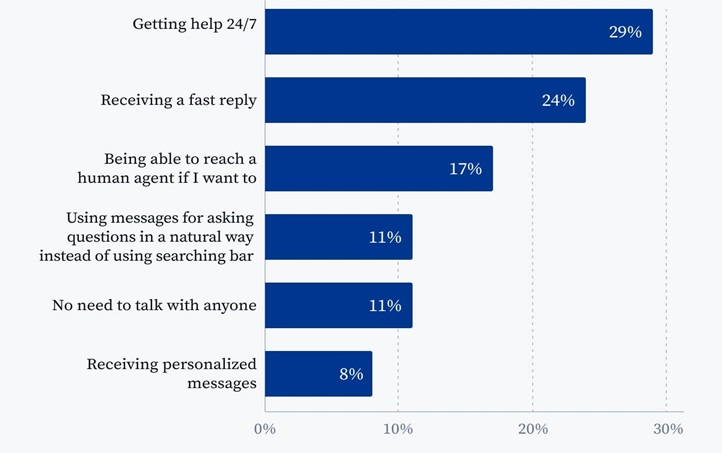Chatbot: Chatbot Assistant

DOI:
https://doi.org/10.54060/a2zjournals.jmss.57Keywords:
Artificial Intelligence, E-commerce, NLP, PYTHON, MLAbstract
Chatbots are a promising solution for order tracking in the digitally connected world. They offer real-time updates and personalized assistance, reducing the need for customers to constantly check their emails or websites. They also provide 24/7 availability, allowing customers to check their order status or seek assistance at any time. Chatbots also collect valuable data on customer inquiries and behaviors, enabling businesses to identify trends and refine their order-tracking systems. They can seamlessly integrate with existing order management systems, making it easier for businesses to adopt this technology without significant disruptions. However, challenges such as data security, user experience, and conversational skills remain.
Downloads
References
B. Newton, & Z. Vassals, Empathic Divergence: Partially Blunting an Affective Empathic Response While Maintaining Cog-nitive Empathy is an Important Skill for Medical Students to Acquire. Medical Research Archives, vol. 12, no. 1, 2023. https://doi.org/10.18103/mra.v12i1.4772
R. Vineeth, R. Rithish, D. V. S. N. Sai Varma, and B. V. Ajay Prakash, “Smart health care Chatbot for prognosis of treat-ments and disease diagnosis using machine learning,” J. Comput. Theor. Nanosci., vol. 17, no. 9, pp. 3947–3951, 2020. https://doi.org/10.1166/jctn.2020.8993
A. N and T. G, “Design and Implementation of Wireless Robotic Arm Model using Flex and Gyro Sensor,” International Journal of Recent Technology and Engineering (IJRTE), vol. 8, no. 5, pp. 2978–2983, 2020. https://doi.org/10.35940/ijrte.e6615.018520
S. Ahanti and K. M. Zubaydulloevna, “AI chatbot-based learning: alleviating students’ anxiety in english writing class-room,” Bulletin of Social Informatics Theory and Application, vol. 7, no. 2, pp. 182–192, 2023. https://doi.org/10.31763/businta.v7i2.659
N. Ouerhani, A. Maalel, and H. Ben Ghézela, “SPeCECA: a smart pervasive chatbot for emer-gency case assistance based on cloud computing,” Cluster Computing, vol. 23, no. 4, pp. 2471–2482, 2019. https://doi.org/10.1007/s10586-019-03020-1
B. Luo, R. Y. K. Lau, C. Li, and Y. Si, “A critical review of state-of-the-art chatbot designs and ap-plications,” WIREs Data Mining and Knowledge Discovery, vol. 12, no. 1, 2021. https://doi.org/10.1002/widm.1434
A. Aabhale, S. Patil, G. Patil, S. Nimbalkar, and A. Kalal, “An AI-Based Medical Chatbot,” International Journal For Multi-disciplinary Research, vol. 5, no. 6, 2023. https://doi.org/10.36948/ijfmr.2023.v05i06.9304
C. M. K. Kappi and L. Marlina, “The Effect of Chatbot Services on Online Shop Customer Satisfaction,” Brilliance: Research of Artificial Intelligence, vol. 3, no. 2, pp. 252–261, 2023. https://doi.org/10.47709/brilliance.v3i2.3133
“An interactive approach to designing for the elderly. A design of an assist cart,” Appl. Ergon., vol. 23, no. 4, pp. 287–288, 1992. https://doi.org/10.1016/0003-6870(92)90197-4
Y. Wijaya and F. Zoromi, “Chatbot Designing Information Service for New Student Registration Based on AIML and Ma-chine Learning,” JAIA - Journal of Artificial Intelligence and Applications, vol. 1, no. 1, pp. 1–10, 2020. https://doi.org/10.33372/jaia.v1i1.638
Researchgate.net. [Online]. Available: https://www.researchgate.net/publication/378213315_Exploring_Capabilities_and_Limitations_of_Generative_AI_Chatbots_in_Solving_Math_Algorithm_Problems. [Accessed: 06-Jun-2024].
Y. K. Dwivedi et al., “Artificial Intelligence (AI): Multidisciplinary perspectives on emerging challenges, opportunities, and agenda for research, practice and policy,” Int. J. Inf. Manage., vol. 57, no. 101994, p. 101994, 2021. https://doi.org/10.1016/j.ijinfomgt.2019.08.002
R. Wittorf, “Learning networks: A field guide to teaching and learning online,” J. Am. Soc. Inf. Sci., vol. 47, no. 10, pp. 797–798, 1996. https://doi.org/10.1002/(sici)1097-4571(199610)47:10
I. M. Cavalcante, E. M. Frazzon, F. A. Forcellini, and D. Ivanov, “A supervised machine learning approach to data-driven simulation of resilient supplier selection in digital manufacturing,” Int. J. Inf. Manage., vol. 49, pp. 86–97, 2019. https://doi.org/10.1016/j.ijinfomgt.2019.03.004
A. S. Almogren, W. M. Al-Rahmi, and N. A. Dahri, “Exploring factors influencing the acceptance of ChatGPT in higher edu-cation: A smart education perspective,” Heliyon, vol. 10, no. 11, p. e31887, 2024. https://doi.org/10.1016/j.heliyon.2024.e31887
D. Verhaest and E. Omey, “The determinants of overeducation: different measures, different outcomes?,” Int. J. Manpow., vol. 31, no. 6, pp. 608–625, 2010. https://doi.org/10.1108/01437721011073337
Y. K. Dwivedi et al., “Artificial Intelligence (AI): Multidisciplinary perspectives on emerging challenges, opportunities, and agenda for research, practice and policy,” Int. J. Inf. Manage., vol. 57, no. 101994, p. 101994, 2021. https://doi.org/10.1016/j.ijinfomgt.2019.08.002
A. Choudhury and H. Shamszare, “The impact of performance expectancy, workload, risk, and satisfaction on trust in ChatGPT: Cross-sectional survey analysis (preprint),” JMIR Preprints, 2023. https://doi.org/10.2196/55399
M. Giuffrè et al., “Systematic review: The use of large language models as medical chatbots in digestive diseas-es,” Aliment. Pharmacol. Ther., 2024. https://doi.org/10.1111/apt.18058
R. M. Summers, “Artificial intelligence of COVID-19 imaging: A hammer in search of a nail,” Radiology, vol. 298, no. 3, pp. E162–E164, 2021. https://doi.org/10.1148/radiol.2020204226
F. Allard-Poesi, “The paradox of sensemaking in organizational analysis,” Organization (Lond.), vol. 12, no. 2, pp. 169–196, 2005. https://doi.org/10.1177/1350508405051187
T. Duong and S. Suppasetseree, “The Effects of an Artificial Intelligence Voice Chatbot on Improving Vietnam-ese Under-graduate Students’ English Speaking Skills,” International Journal of Learning, Teaching and Educational Research, vol. 23, no. 3, pp. 293–321, 2024. https://doi.org/10.26803/ijlter.23.3.15
J. Zhang and D. Tenney, “The Evolution of Integrated Advance Persistent Threat and Its Defense Solutions: A Literature Review,” Open Journal of Business and Management, vol. 12, no. 01, pp. 293–338, 2024. https://doi.org/10.4236/ojbm.2024.121021
R. Al-Jarf, “Students’ assignments and research papers generated by AI: Arab instructors’ views,” Journal of Computer Sci-ence and Technology Studies, vol. 6, no. 2, pp. 92–98, 2024. https://doi.org/10.32996/jcsts.2024.6.2.11
W.-J. Chang, P.-C. Chang, and Y.-H. Chang, “The gamification and development of a chatbot to promote oral self-care by adopting behavior change wheel for Taiwanese children,” Digit. Health, vol. 10, 2024. https://doi.org/10.1177/20552076241256750

Downloads
Published
How to Cite
CITATION COUNT
Issue
Section
License
Copyright (c) 2021 Rakshita Rajan Singh, Dr. P. Singh

This work is licensed under a Creative Commons Attribution 4.0 International License.
























